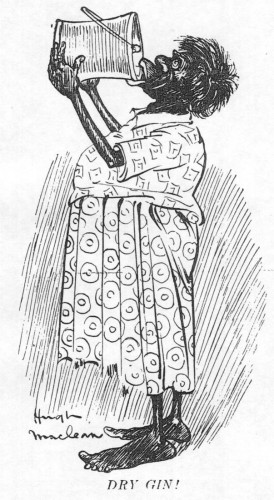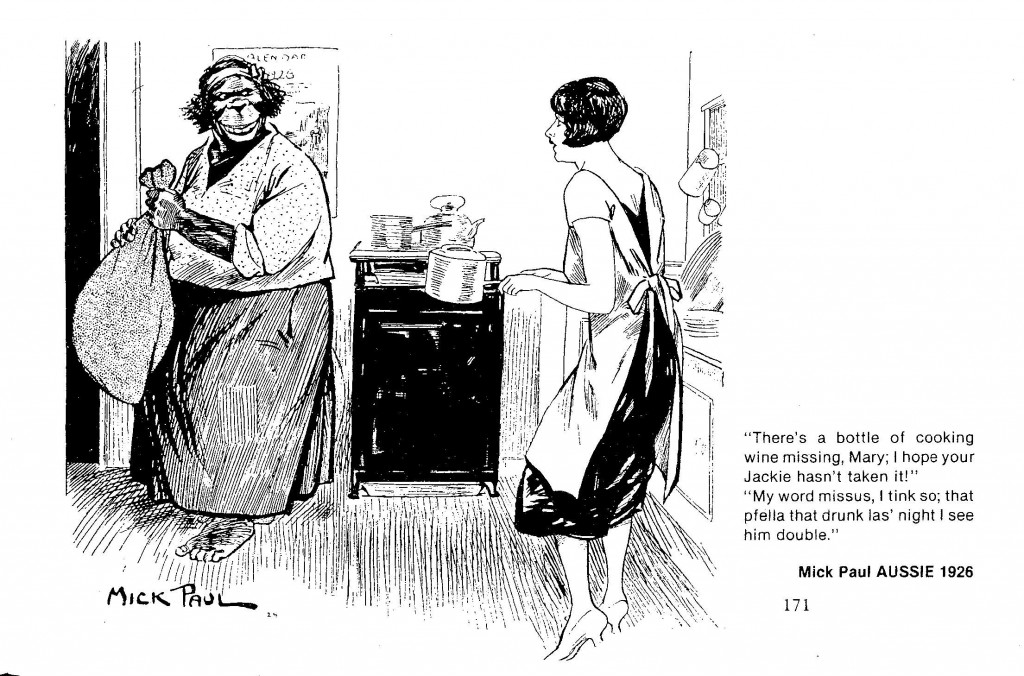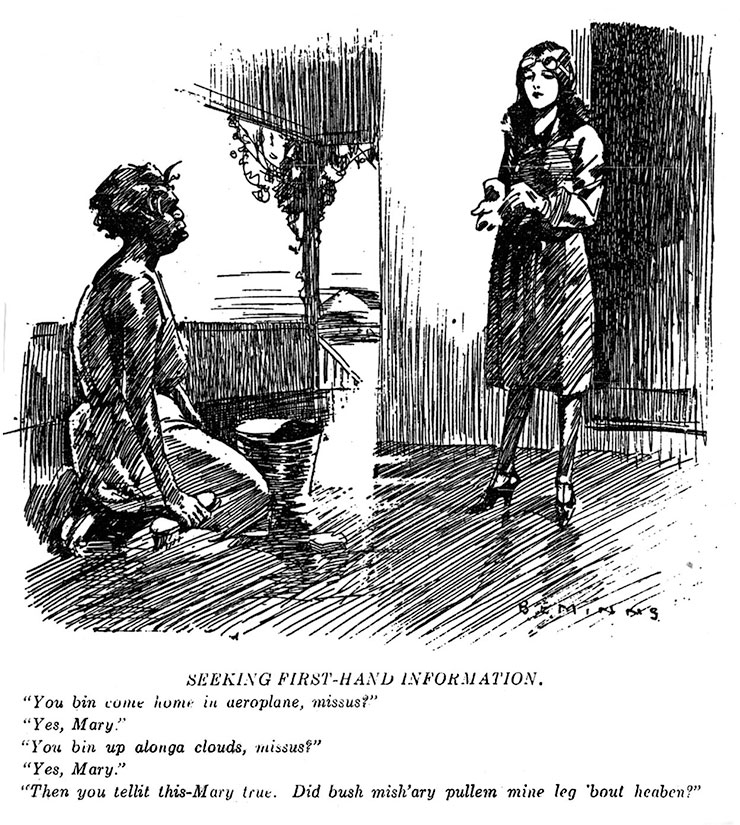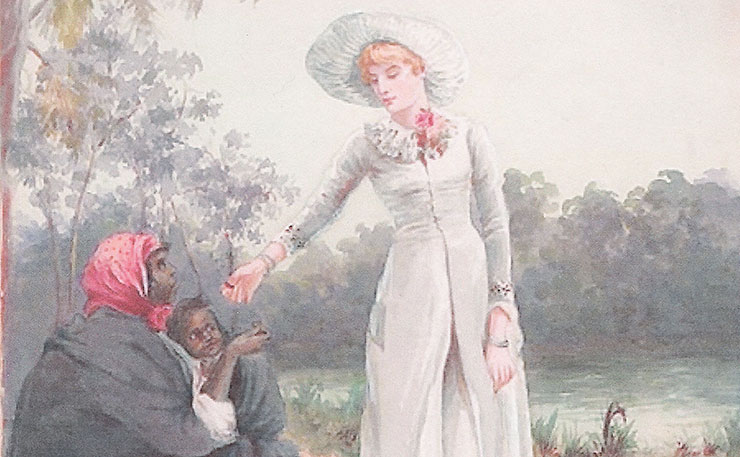Following on from the controversy engulfing Facebook over the depiction of Aboriginal women and culture, here’s an excerpt from a soon-to-be-published book, Skin Deep, by Dr Liz Conor.
READER WARNING: This story contains images and illustrations that are highly offensive by contemporary standards, and will upset some readers, in particular Aboriginal people. They are republished here to demonstrate recurring tropes of Aboriginal women elders that are racist and misogynistic.
The optics of women’s public nudity are notoriously myopic. Many a feminist, by now, has upbraided the duplicity of breastfeeding women being shamed, while virtually in the shadow of hoardings, giving ample eye-suckle to passing heteroblokes.
Scandal after scandal has broken on Facebook following its unilateral censuring of selective naked breasts, inciting free-the-nipple picnics and other breast-flailing expressions against slut-shaming.
But the latest fracas involving Arrernte woman and writer Celeste Liddle, and the image of painted Ampilatwatja women performing ceremony, references more than just discriminatory publishing of naked breasts by Facebook and, by extension, the wider mediascape.
There is a long history of settlers deriding the nudity of women elders that reflects more on their fears than on the women who were, unsettlingly, completely indifferent to their discomfort and offence.

In the early years of incursion onto Aboriginal homelands, settlers very much hoped to catch a glimpse of the ‘native belle’ spied, through eyeglasses, on the discovery voyages by Wallis, Bougainville, La Perouse and Cook to the Pacific isles.
These ‘accommodating’ young women were thought to be free from the constraints of European sexual scruples, which rather conveniently made them more sexually available to the voyagers and their crew.
In the colonies of Australia, as violence infused these encounters, the ‘lubra’ was said to be ‘easy for the taking’. Her primitivism was thought to make her more libidinous. Her purported lack of marriage ceremony made her unprotected quarry.
Young Aboriginal women were undoubtedly exceedingly vulnerable to sexual violence on the Australian frontiers. These European visions of the Australian ‘native’ woman were looks riveted by the twin compulsions of aversion and allure.

This Native Belle type was a naïve beauty unwitting of the impact of her beauty. It was up to white men to salvage that beauty as a kind of redemption from the ruin of the tribal and as a show of colonial chivalry. But elder women, as far as settlers could see, served no purpose whatsoever. Compared to the ‘dark belles of the gum forest’, they were ‘unsightly’, ‘hideous and haglike’.
Cast within the shadows of the Australian bush-gothic postmaternal women were seen as a malevolent presence within the fraught and sometimes eerie landscape that was both desolate and entrapping. The less human and more wraith-like they appeared, the more they embodied a settler dread that terra nullius would always be haunted by visions of a watching specter, crouched and brooding, disturbing the peace.
Ethnological interest in the racial test of beauty informed the logic of scientific spectacle (and its commercialization), and cast both the monstrous or differently beautiful native woman as specimen of racial difference. But the distinction between European and Indigenous women was made through their very different relation to feminine beauty: women whose nudity was indifferent to the gaze of European men were allotted with gorgon-like potencies.
Part of the hubris of colonialism was the ‘conquest of the world as perspective’. Through mapping and surveying, the unknown world came under the dominion of Europeans with their refracting telescopes and chartography. This conquesting gaze was directed to the bodies of ‘natives’ through craniometry and anthropometry.
The adopting of European standards of dress and beauty by Indigenous women would be a central concern of missionaries and colonial administrators as the ‘civilising mission of dress’. An immoderate fondness for ornament in white women, however, revealed their ‘savage passion’, like ‘natives’ for feathers and skins, etc.
‘Native populations’ were partly administered by conflating racial difference with visual abjection. The Report of the Select Committee of the Legislative Council on the Aborigines in 1860 quotes ethnologist Professor Owen on his calculation of the facial angle and its relationship to intelligence:
“If a line… be drawn from the occipital condyle along the floor of the nostrils, and be intersected by a second touching the most prominent parts of the forehead and upper jaw, the intercepted angle gives, in a general way, the proportions of the cranial activity and the grade of intelligence: it is called a facial angle. In the dog this angle is 20°, in the great chimpanzee, or gorilla, it is 40°, but the prominent superorbital ridge occasions some exaggeration; in the Australian it is 85°, in the European it is 95°. The ancient Greek artists adopted in their beau ideal of the beautiful and intellectual, an angle of 100°.”

Evidently Professor Owen had not made acquaintance with a pug. Facial angle was a key indice of civilisation, and the ‘prognathous’ form of skull was set at a ‘low’ angle among Aborigines. This visual politics assembled ‘primitive’, ‘sexual deviant’ and ‘physically impaired’ into the nexus of race-grotesque.
The ethnologist Ramsay-Smith described Aboriginal men as having ‘deep and broad chests’ and remaining ‘lithe, active and supple to a very great age’. Women did not fare so well, however, for he said they ‘as a rule, “go off” in condition early, probably on account of the hard work and privation to which they are subjected’.
Note that hard work forged older men into impressive physiques, while it corroded women away.
The notion of premature aging of ‘native’ women fed into and buoyed the pervasive theory of dying race. And this idea that Aboriginal women aged prematurely was particularly focused on their breasts. The postmaternal breast was particularly repellent to European men unused to their public exposure, and used to the décolleté uplift of the ballroom bosom.
Naked women was one thing, but elderly women, naked and outdoors – it was more than an affront.
In a popular 1933 pictorial book, We Find Australia, the author, Charles Holmes describes Aboriginal women as “the most repulsive women I have ever seen” having “distended stomachs”, “flat and long” breasts, “terribly gawky” legs and a “mass of matted mess” for hair.
Holmes also took offence at the festooning of breasts in loops of white paint, giving women “a skeleton-like appearance”. It was their breasts, the very capacity of women to continue their race that rendered them hideous to newcomers.
Again and again the inference was made that a disappearing people was of less concern if they were unsightly.
In 1915 Aboriginal women were imaged as “An Ugly Blot on Australia” in the frontispiece of Inlander, the quarterly magazine published by the Presbyterian Church of Australia. Printing an image, which doesn’t bear reproducing here, of a slight woman covered from waist to knee with a child on her hip, the Inlanders’ intention was to mobilise in Australian citizens “more compassionate thought to the care of aged black women in our land”.
However, she instead confirmed the status of Aboriginal mothers and their grandchildren as literally out of place in the Australian modern scene:
Quite apart from humanitarian consideration for the natives, we feel that the presence of emaciated and often positively diseased blacks is a national danger to us. What may not happen through flies passing from such creatures to settle on little white children on the Inland? Again, what must be the effect on the hearts and minds of little children if compelled to grow accustomed to the sight of ‘Blots’ in human form?
Her monstrosity is conflated with her Aboriginality, which remains outside the category human, and should be extirpated from white children’s view if they are to form an appropriate picture of the nation in which they will take their ordained place.
Settler accounts of elder women comprise a hideous and confronting archive, but one that bears witness to the misapprehension of settlers when facing off with women who embodied the gravitas and authority of the elder.

What we see in the offence taken at the painted Ampilatwatja women New Matilda reproduced is a rerun of the original offence taken by settlers.
Scars made in mourning and other lifecycle rites were attributed to the “ill-treatment from their ferocious husbands”.
Postmaternal breasts, in fact revered for pointing down to feeding children’s mouths, were described as “flaccid and pendulous”. The notion that breast desirability could be decided by children, according to maternal skill and experience, rather than visual appeal to men, was a startling reclamation from the gaze of European men.
As ethnological specimen, as tribal Native Belle, as fashioned to assimilate, or as ‘unsightly’, Indigenous women had limited prospects to articulate their own visual identities.
That elder women are still cast as illegitimate within modern visual relations is galling not only because of the unique and exemplary authority and respect that should be accorded to Aboriginal elders. This form of dehumanizing is also painful to witness because of their valiant struggle to protect their children and grandchildren from the worst interventions by white administrators, and to pass on their way of being while coping with their own trauma, deprivation and grief.
For their frailty as elders to be cast as monstrous is a slur whose disrespect reaches back to the worst excesses of Australian racism, when despised appearance was a means to assert racialised power, capable of withholding cultural presence and legitimacy.
Donate To New Matilda
New Matilda is a small, independent media outlet. We survive through reader contributions, and never losing a lawsuit. If you got something from this article, giving something back helps us to continue speaking truth to power. Every little bit counts.





